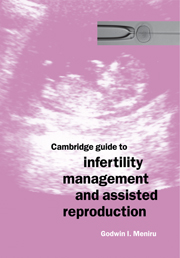Book contents
- Frontmatter
- Contents
- Preface
- Foreword
- Acknowledgements
- Introduction
- 1 The male reproductive system
- 2 The female reproductive system
- 3 Fertilization, implantation and early development
- 4 Male factor problems
- 5 Female factor problems
- 6 Evaluation of the infertile couple
- 7 Medical and surgical treatment of infertility
- 8 Conventional in-vitro fertilization treatment
- 9 Intracytoplasmic sperm injection
- 10 Surgical sperm retrieval
- 11 Intratubal replacement of gametes and embryos (GIFT, ZIFT)
- 12 Intrauterine insemination
- 13 Cryopreservation of gametes, ovarian tissue, testicular tissue and embryos; frozen embryo replacement
- 14 Assisted hatching
- 15 Preimplantation diagnosis of genetic disease
- Appendix: Acronyms in assisted reproduction technology
- Index
15 - Preimplantation diagnosis of genetic disease
Published online by Cambridge University Press: 11 September 2009
- Frontmatter
- Contents
- Preface
- Foreword
- Acknowledgements
- Introduction
- 1 The male reproductive system
- 2 The female reproductive system
- 3 Fertilization, implantation and early development
- 4 Male factor problems
- 5 Female factor problems
- 6 Evaluation of the infertile couple
- 7 Medical and surgical treatment of infertility
- 8 Conventional in-vitro fertilization treatment
- 9 Intracytoplasmic sperm injection
- 10 Surgical sperm retrieval
- 11 Intratubal replacement of gametes and embryos (GIFT, ZIFT)
- 12 Intrauterine insemination
- 13 Cryopreservation of gametes, ovarian tissue, testicular tissue and embryos; frozen embryo replacement
- 14 Assisted hatching
- 15 Preimplantation diagnosis of genetic disease
- Appendix: Acronyms in assisted reproduction technology
- Index
Summary
Introduction
Genetic disorders are not uncommon, affecting 1–3% of individuals at birth. Some are incompatible with life, leading to death in utero or at some stage (days to years) after birth. Two approaches have been adopted towards the management of these illnesses namely prevention and treatment. Curative treatment has so far been impossible but supportive treatment may improve quality of life and life expectancy in some cases. A number of preventive measures are possible depending on the circumstances. A few individuals may choose the option of not getting married at all but many couples may already be married by the time the disorder is discovered in one of the partners, their parents, children or siblings. Another preventive measure is to choose a partner whose genetic constitution guarantees that offspring from the union will not manifest the clinical effects of the disease although they may be carriers, for example sickle cell anaemia and thalassaemia. These are autosomal recessive diseases and will usually manifest clinically only in the homozygous condition. Other couples have chosen not to have children especially when the problem is invariably fatal and manifests even in the heterozygous state. One other option is the use of donor gametes, in place of one or both partner's gametes, to generate embryos that are free of the disease in question, using artificial insemination or in vitro fertilization (IVF). Donor embryos can also be used in cases where both donor sperm and oocytes are required.
- Type
- Chapter
- Information
- Publisher: Cambridge University PressPrint publication year: 2001



